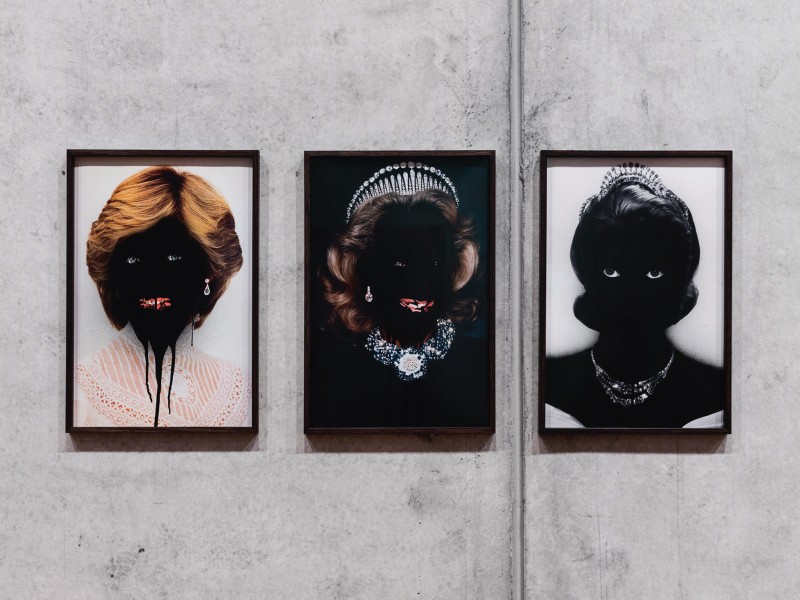Encounters with chthonian spirits—who leave their subterranean dwellings only when the beasts wake them—are rare. Talking to Monika Bielskyte, the Lithuanian-born creative director, consultant, strategist and self-proclaimed “techno nomad”, is like conversing with a good friend you might have only known from a prior life. You feel in good hands with her. When we spoke, she had just returned to Los Angeles from Cape Canaveral, Florida, where she witnessed the SpaceX rocket launch. She shared the view on Instagram: a grisly orb of light that ascends into black sky, as if guided by a string tied to poles of fire and gravity. “The rocket footage is nothing like what you can see in reality because we don’t have the adequate capturing technology,” she regrets. “It’s a big historical moment because it’s the first time they’ve vertically landed a rocket.” In one of her clips, two incandescent specks appear to hover in deep space before closing in on the distance between them. The rocket, delicate and yellow as a firefly, consorts daffily with the moon. “It’s the first rocket I’ve seen take off,” she says. “The last time they attempted such a feat it exploded.”
Bielskyte was born in Šiauliai, Northern Lithuania, in 1986. The city never buoyed its own cultural scene after the two world wars—the first of which decimated over 80 per cent of its buildings—but is famous, instead, as a stop along the way to the nearby Hill of Crosses: a spectral mass of crucifixes that, in 1993, Pope John Paul II unofficially declared to be a holy site. “I don’t come from some kind of privileged background, nor do I come from one of those metropolises like New York or Paris, where you can grow up with culture,” she pines. “My family, although regular people, were intellectuals. However, the environment I grew up in wasn’t particularly diverse.” Children in allegorical cultural slums eventually find their own ways to lift off and imagine alternate worlds. At 10, Bielskyte began to draw and paint and sculpt. The characters in books become her friends and confidantes. She developed her own films and produced prints in a mini lab in her bathroom. In 2006, at the mere 20 years of age, Bielskyte published Times Immemorial to showcase a collection of photographs taken in Nepal, India and Bhutan. In 2008 she exhibited a selection of her photography at FOAM Photography Museum in a show titled A Place to Wash the Heart.
Before Bielskyte began chasing astral lights, she danced with terrestrial ones. She first launched a magazine called Some/Things. “When I started I really had no clue about press,” Bielskyte admits. “The magazine was born of a desire to collaborate. I wanted a magazine that resembled a book, with interviews that read like dialogue from a great novel, and imagery that evoked the cinematography of film.” American photographer Roger Ballen and Chinese-American artist Zhang Huan were early fans of the magazine. However, it was Rick Owens and Michèle Lamy—partners in work and life—who conspired with Bielskyte to make the darkly perfumed imagery she siphoned into the magazine.
“There are few design creatives who reach the same level as Rick,” Bielskyte remarks, in strands of speech that slither into awe. “He and Michèle build worlds and fill them with characters. It’s beautiful and grotesque because people try to imitate him, in attempt to belong.” Owens and Lamy feature in five consecutive issues of Some/Things. The torrent of snapshots move from the pairs Paris atelier to their Palais Bourbon home. Other scenes are intimate depictions of Owens’ alabaster and plywood furniture: proud, phallic wooden membranes atop short, worried legs. When Bielskyte discovered that Lamy used to sing “before she was so publicly prolific”, she upholstered Lamy in front of a camera, turned up the music, and started shooting. In a 2010 series of photographs of Rick Owens, Bielskyte depicted the designer in three solemn phases. He looks like the moon through the wrong end of a telescope: joyous and remote, swamped in brittle shadow.
Bielskyte’s practice slowly skated from fashion to prototyping futures, undulating between architecture and design. In 2012, she collaborated with famed architect Claude Parent on Imaginary City. “I called him my spiritual grandpa,” she muses. “He was truly one of the youngest people I knew. He was so open and his eyes literally shone with curiosity and wonder.” Together, they created a scale city that at the right squint, resembled Brutalist honeycombs. Indeed, Parent’s future cities concept was the source of inspiration for many architects such as Rem Koolhaas and Herzog and de Meuron, and film makers such as Gattaca’s Andrew Niccol. Bielskyte was later invited by Spanish architect Ricardo Bofill to visit La Fábrica, which he began reconstructing in 1973 from the derelict face but superb bone structure of a cement factory. It is celebrated by experts as a lordly marriage of spatial cunning and surrealist delight—staircases that lead to nowhere, giant silos that contain nothing, vines that swing in the elegiac and exhausted air. To Bielskyte, though, it is a foretaste of the future. “It may be the most beautiful house I’ve ever seen,” she joys. “An industrial complex that was recycled into a house and a studio, where futuristic design meets local Catalan architecture. It’s the integration of history, culture, nature and everything high tech.”
You suspect it’s Bielskyte’s dirty minded regard for high minded scholarship that pulls her back to the world of technology. This is where her scruples about hero worship suddenly dissolve: physicists are her rock stars. Her final major project with Some/Things involved meeting the brilliant minds at CERN, the European Organisation for Nuclear Research, in Switzerland. “We went underground, saw the most exquisite machinery, and photographed the Atlas and the Compact Muon Solenoid experiment. They are trying to discover how the world functions on a small scale which, by extension, tells us how it functions on the largest scale imaginable,” she reminisces. “You see old people, young people, people with dreadlocks, people with tattoos, and people of a diverse range of races and religions, all working together.” Bielskyte’s imagination is future orientated, both textured and buoyant. Her identity is a mixture of mythology, Asian aesthetics imbued with Eastern European sensibilities so thick and thorough it borders depravity. She appears to admire physicists because they dart between disciplines and approach the unknown with noble intentions. Bielskyte swiftly left Some/Things in 2013 to explore the new frontiers in science and technology. “I changed radically by changing circles,” she says.
Bielskyte has increasingly become devoted to the science behind augmented reality (AR) and virtual reality (VR). Both technologies have piqued the world’s interest and baited billions from investors. In AR, opaque, three-dimensional holograms are embedded onto our view of the real world; in VR, viewers are immersed in an entirely artificial environment simulated by stereoscopic technology. Magic Leap is a lodestar in the field of AR technology. The company, which first launched in 2010 by American entrepreneur Rony Abovitz, is a Googlebacked operation that specialises in producing head mounted virtual retinal displays. Magic Leap’s technology beams light signals directly onto the retina so that projected and actual light mingles in our field of vision. Simply put, the brain is tricked into seeing things that are not there in any traditional sense.
At the vanguard of virtual reality technology is Oculus VR, the Facebookbacked start-up aspiring to dominate family entertainment. “There [are] two broad camps,” John Carmack, chief technology officer at Oculus, told Wired UK. “The hardcore academic research people look down their noses at games. It was all about remote surgery and high-minded things.” Though VR technology is still crude, it promises court-side seats at concerts and sporting events, immediate consultations with doctors, and greater access to classroom education. “It’s the future of computing,” Bielskyte asserts. “It’s how we will create and consume content. The future of this interface is that there is no interface.” Both AR and VR technology are subject to privacy concerns due to the enormous amount of data required to create and maintain their respective worlds: bystanders who have not adopted the technology will inevitably be involved as passive participants. Bielskyte bristles at the mention of its potential in warfare. “How can we create something that adds to people’s lives?” she interrogates. “I struggle with the word ‘better’ because that implies some kind of moral truth. I don’t know what’s better, but I do know what’s worse. Perhaps we should say more humane, beautiful, or inspiring?”
I struggle with the word ‘better’ because that implies some kind of moral truth. I don’t know what’s better, but I do know what’s worse. Perhaps we should say more humane, beautiful, or inspiring?
Bielskyte’s latest venture is All Future Everything (AFE), a digital platform at the junction between culture and technology powered by friends who jump time: staying ahead by immersing themselves into the thick of it. “It’s all about people who are changing the world,” she dotes. “I’m not really interested in hearing people speak about themselves. If you can talk about what you care about, what you don’t understand, what could be done, what should be done, the conversation is infinite.” Bielskyte is adamant that, moving forward, sustainable thinking will be integral to her practice. “I think digital waste is also waste,” she says. “Thinking sustainably is about creating content that isn’t just more stuff.” Occasionally, Bielskyte leaves the sky to orbit more familiar celestial bodies. “I’m doing a lot of stuff in Hollywood, working with some prominent filmmakers and directors to producing visual and conceptual frameworks as well as developing strategies and technologies for their movies,” she says. “I want to truly collaborate with people who value conversation.”
All remarkable people know the one vital truth of success: the paths are serpentine. At 26, after years of arduousness, Bielskyte travelled to the Beppuregion of south Japan, checked in to the ryokan, and drowned in the hot springs. “My mind was there but my body didn’t react,” she recalls. “I woke up as they dragged me out of the water, threw up, then passed out again. I was hallucinating and had a fever of 42ºC. It was a brutal, violent experience. I was hospitalised in intensive care, my life functions sustained by the medical equipment and the incredible medical staff.” Following this experience Bielskyte escaped to Iceland, where the “elves, the trolls, and the volcanic earth made everything clear”. Iceland has quickly become a turning point in Bielskyte’s growth, connecting her to what she conceives as her true resilient soul. If Bielskyte ever appears to be submerged in her own solemnity, it quickly dissipates when she talks about being mindful and thankful in vast profusions. She reminds us we’re the stuff of condensed galaxies and vestigial stardust—the universe eternally observing itself.

